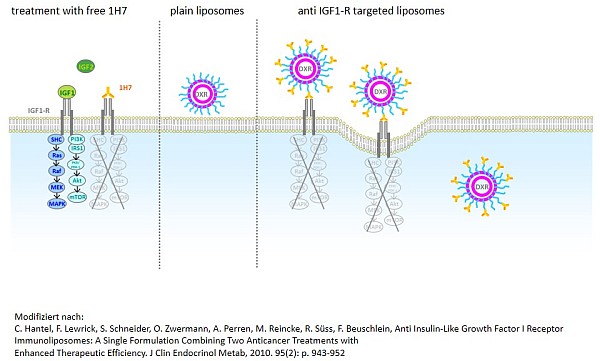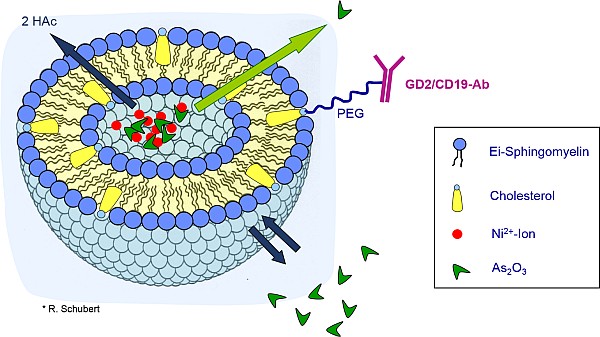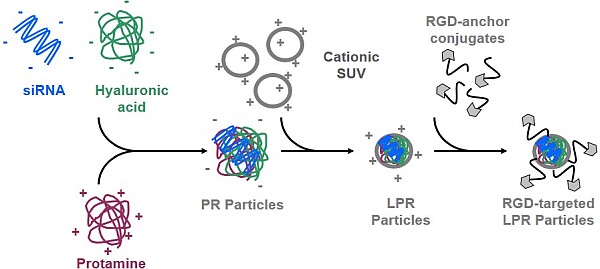Tumor Therapy
Jump to the middle of this page
Anti-IGF1 Receptor-modified Liposomes for Treating Endocrine Tumors
In collaboration with the Department of Endocrinology, University Hospital Munich, Germany (Professor Dr. Felix Beuschlein, Dr. Constanze Hantel), the group of Professor Dr. Regine Süss develops novel therapeutic approaches for treating adrenal carcinoma and malignant gastrointestinal tumors (PhD theses by Dr. Andreas Fritze, Dr. Felicitas Lewrick, and Judith Jakoby).
By means of actively targeted liposomes, we already addressed several targets in endocrine tumors such as the ACTH receptor, the SRIF receptor type 2, and the IGF1 receptor. In in-vivo experiments, an anti-IGF1 receptor-targeted preparation of doxorubicin-loaded liposomes turned out especially efficient in terms of therapeutic promise. In this formulation, the ligand serves both as a homing device and a therapeutically active hormonal agent. We could already demonstrate for such anti-IGF1 receptor-targeted liposomes a supra-additive effect of the two drugs after single dosing in vivo.
In further studies, we will now analyze the uptake mechanism as well as the therapeutic efficacy of these preparations upon multiple dosaging and in individualized tumor models. Moreover, our preliminary investigations indicate that this preparation could likewise be an effective treatment regimen for other entities of malignant tumors, so that it might be established for a broad range of applications.
Funding
This project has been funded by the Dr. Mildred Scheel Foundation for Cancer Research (Germany) since 2012.
Lewrick F, Süss R: Remote loading of anthracyclines into liposomes, Methods Mol. Biol. 605, 139-145, 2010. [Epub]
Hantel C, Lewrick F, Schneider S, Zwermann O, Perren A, Reincke M, Süss R, Beuschlein F: Anti insulin-like growth factor I receptor immunoliposomes: A single formulation combining two anticancer treatments with enhanced therapeutic efficiency, J. Clin. Endocr. Metab. 95, 943-952, 2010. [Epub]
Fritze A, Hens F, Kimpfler A, Schubert R, Peschka-Süss R: Remote loading of doxorubicin into liposomes driven by a transmembrane phosphate gradient, Biochim. Biophys. Acta - Biomembranes 1758, 1633-1640, 2006. [Epub]
Anti-IGF1-R-modified Liposomes for Treating Ewing's Sarcoma
Because of the high sensitivity of Ewing's sarcoma to doxorubicin and to anti-IGF1-R-antibodies, anti-IGF1-R-targeted formulations provide a very promising treatment strategyfor this disease. Their effectiveness will therefore be examined in collaboration with Professor Dr. Udo Kontny of the Center for Pediatric Hematology and Oncology, ZKJ, Freiburg, Germany, in their established mouse xenograft models of Ewing's sarcoma (PhD thesis by Judith Jacoby).
Liposomes loaded with Anti-cancer Drugs for Treating Neuroblastoma and Leukemia
In a collaborative approach with Professor Dr. Rupert Handgretinger (Children's Hospital, Tübingen, Germany) we are working on the stable liposomal encapsulation of arsenic trioxide (ATO). To this end, nickel acetate is encapsulated within the hydrophilic core of rigid liposomes made from egg sphingomyelin, which leads to the precipitation of a nickel arsenic ion complex and, thus, to a stable inclusion. We are striving for specific drug targeting as based on earlier doctoral dissertations at this Department (Dr. Felicitas Lewrick) so as to achieve local accumulation of the liposomes within the tumor environment; this will help avoid the increased concentrations in blood plasma that would be necessary for an effective therapy but may cause side-effects such as kidney or heart failure. To this end, after preparing the nickel / arsenic-containing liposomes, their surface is modifiedvia the so-called post-insertion technique by an anchor conjugated with a specific antibody..
This liposomal preparation shall be employed for treating solid neuroblastoma tumors (PhD theses by Ines Müller and Hannah Deibel). In this case, the surface is modified with a disialoganglioside 2 (GD2)-specific antibody. Building upon this experience, we are modifying liposomal preparations by CD19-specific antibodies so as to optimize a treatment for lymphatic (pre-B-cell) leukemia. These future projects also comprise the encapsulation of other anti-cancer drugs besides ATO (PhD thesis by Kathrin Züfle).
Funding
This project has been funded by the Foundation for Neuroblastoma Research e.V., Baden-Baden, Germany) since 2010.
(middle of this page)
Liposome-Protamine-siRNA (LPR) Particles for Treating Rhabdomyosarcoma
Alveolar rhabdomyosarcoma(ARMS)is among the most commonsoft-tissue sarcomas in children; state-of-the-art treatment is only rarely successful. In a collaborative setting, the groups of Professors Dr. Regine Süss (this Department) and Dr. Jochen Rößler, Center for Child and Youth Medicine, University of Freiburg, Germany, are exploring a novel therapeutic approach: Here, sequence-specific siRNA constructs shall selectively downregulate ARMS structures as well as inhibit oncogenes. Intracellular uptake, distribution and availability of the siRNA constructs are to be improved by being combined with suitable carrier systems. With this objective, liposome-protamine-siRNA(LPR) formulations were developed and successfully evaluated in vitro. Additional modification of these carriers with antibodies and peptides directed against AMRS surface structures shall enable to selectively address these tumors in vivo (PhD thesis by Doris Zimmer).
Funding
This project was funded by the German Research Foundation (DFG) from 2009 to 2011.
Liposomes featuring Boron-containing Lipids for Boron Neutron Capture Therapy (BNCT)
Boron neutron capture therapy (BNCT) of malignant tumors implies the irradiation of 10boron-containing molecules with thermal neutrons in close proximity to tumor cells. Uptake of a neutron into the atomic nucleus of 10boron causes a nuclear reaction leading to the formation of the unstable 11boron nucleus and its subsequent decay into 7lithium and an α particle. These particles damage cells and tissue at a radius of about 10 microns, which approximately corresponds to a cell's diameter. Since neither the neutron radiation nor the boron-containing molecules, ideally, act by themselves toxic on the organism, side-effects are not expected. It is, however, a challenge to reach effective 10boron levels within the target tissue. For this reason, we intend to utilize liposomes as suitable carrier systems.
In collaboration with the group of Professor Dr. Detlef Gabel, University of Bremen, Germany, we synthesize novel boron-containing lipid structures that are incorporated within liposomal membranes. These preparations are examined as to their stability, cellular uptake, influence on the cells' vitality, and further parameters (PhD thesis by Alexander Burghardt).
Funding
This project has been funded by the German Research Foundation (DFG) since 2007.
Schaffran T, Lissel F, Samatanga B, Karlsson G, Burghardt A, Edwards K, Winterhalter M, Peschka-Süss R, Schubert R, Gabel D: Dodecaborate cluster lipids with variable headgroups for boron neutron capture therapy: Synthesis, physical-chemical properties and toxicity, J. Organomet. Chem. 694, 1708-1712, 2009. [Epub]



